We're pleased to introduce a new listing of Online Class Time listings, which you will find here:
https://www.violinschool.com/online-class-times/
We are excited to finally be expanding our program of live classes, and look forward to seeing you online! Please do not hesitate to contact us at [email protected] if you have any questions.
We are starting to roll out our updated online courses this week, and will be onboarding existing learners and members in the coming days. Enrolment for new learners will be available from next week.
Stay tuned to this blog for updates!
We've added the Digital Notation player to this uplifting track for Beginner Violinists ... As you get to know the names of the open strings (G, D, A and E), play along with the track to hear and see the letters for the first time!
If you're new to the violin, try plucking the strings first, using the fingers directly on the fingerboard of the violin. Once you're comfortable with using the bow, try the piece again arco (with the bow)!
(VS Membership required!)
I Am The Captain Of A Pirate Ship is a favourite Beginner Duet from the book Lollipop Man by Anita Hewitt Jones. It's a great piece for Beginner violinists (Level 1) and is based on the D Major scale in 1st position.
If you're practising the piece on your own, mute the other part on the digital notation player, then you can play a duet with your computer or phone!
Practise singing before you play!
Here are some useful words that you can use - they fit rhythmically with the top line (Part 1):
I am the Captain of a Pirate Ship!
I am the Captain of a Pirate Ship!
Pirate Ship, I'm the Captain of the Ship
Yes I am the Captain of a Pirate Ship
Pirate Ship, I'm the Captain of the Ship
Captain of a Pirate Ship!
Click below to play the piece (VS Member Login required). Don't forget to mute the other part so that you can play along with your computer!
(VS Membership required!)
The first digital notation is now being added to our scales pages. Here's G Major in 1 Octave (separate and slurred bowings) ... click the image to listen and play with the music! (membership login required)
(VS Membership required!)
Here's the digital notation to Tick Tock, Tock Tick, a beginner piece for first-time players to practise moving between strings on the violin:
(VS Membership required!)
For 2020, we're excited to be introducing the superb SoundSlice digital notation player into all of our courses and our online library.
Over the coming weeks, we'll be gradually adding this great new tool to all of our pieces and exercises, for all ViolinSchool members to use in their practice.
For beginners, we've just updated Pull Some Strings, a useful set of introductory exercises to help first-time players recognise the notes for the first time.
Click the image below to try out the new player! (login required)
(VS Membership required!)
This gorgeous new track is inspired by luscious, green forests where the mist floats mystically above the trees ... Try playing along with the beautiful soundtrack of this new Level 2 piece:
(VS Membership required!)
Do you use Finger Patterns? They're a really useful way of thinking about where to put your fingers on the violin.
Why are they so useful?
Well, if you know which finger pattern you need for a particular key, you don't need to worry about remembering each interval. You just remember the shape of the hand instead!
Here's Finger Pattern 1 ... this pattern is a good place for beginners to start, because it's the pattern we use for the G, D and A Major scales in first position.
You'll need these distances between the fingers:
Here's a visual image of Finger Pattern 1, from ViolinSchool's Course B:
Course B Parent and Child - Finger Pattern 1 - 1.1.9 - ViolinSchool
(VS Membership required!)
Here's a little bit of news about what’s coming up at ViolinSchool in the next few months…

More Online Lessons & Courses
From January on, we‘ll be releasing several new and upgraded lessons each week on ViolinSchool.com.
You’ll be able to follow what’s new on our daily blog, and the top new videos will be sent out through social media and our weekly emails as well.
We'll be releasing a lot more video, including loads on our YouTube channel - so if you're not already subscribed, do click over to YouTube and follow us there!
On ViolinSchool.com itself, there’ll be lots of premium video tutorials, to help you with all the details of the music theory as well as the violin technique.

Digital Music Player
You may have already seen the lovely new digital notation player starting to appear on some pages at ViolinSchool.com.
The good news is that we are now going to roll it out to almost *all* of the music and exercises in our library, and to all of the lessons in our courses as well!
The player lets you listen to each piece but it also allows you to speed it up, slow it down, loop it, cut out some of the parts, and more.
You can even see a visualisation of where to place your fingers on the fingerboard, as you listen to the music.
It’s a really great tool for practice, and we’ve already seen some amazing results from learners who have started to use it, so if you haven’t already done so, please give it a try!
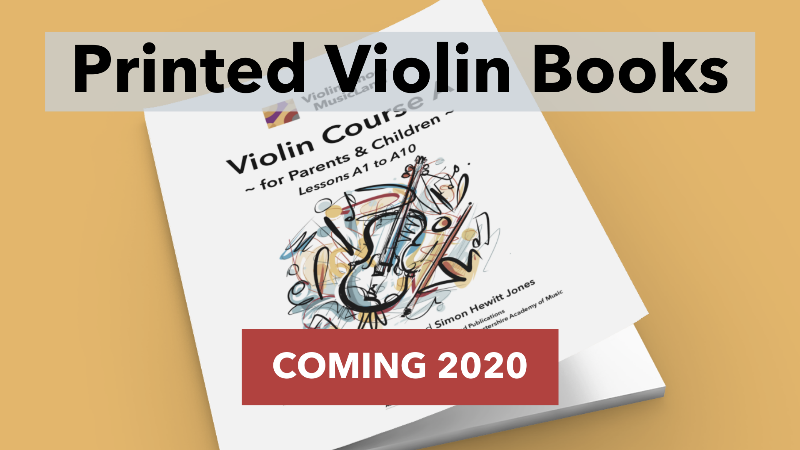
Printed Books
In 2019, we created our first two printed books, featuring activity-based lessons for beginners.
The books are designed in a clean, easy-to-follow sequence that matches up directly with the online courses, and they’re great fun for learners of all ages.
We’ll make these available publicly during 2020, and there are loads more to come as well - so stay tuned!
**
All of us here at ViolinSchool are looking forward to helping you learn and achieve your goals in 2020 ... Here’s to a great New Year!
We're preparing a giant upgrade for ViolinSchool.com over the holidays. The Courses section of the site may be unavailable. During this time, enrolled learners can access courses directly here:
FREE COURSES
Get Started With The Violin
https://www.violinschool.com/course/how-to-get-started-with-the-violin/
Beginner Quick Start
https://www.violinschool.com/course/beginner-quick-start/
ALL COURSES
Course A (Adult Learners)
https://www.violinschool.com/course/course-a/
Course A - Parent & Child
https://www.violinschool.com/course/course-a-parent-child/
Course B - Parent & Child
https://www.violinschool.com/course/course-b-parent-child/
Click the image to watch our Christmas Message!
Wherever you are and whatever you're doing this Holiday season, we wish you peace and happiness!
In 2020, ViolinSchool is launching our most ambitious ever program of violin lessons, courses and learning resources - including new books, teacher training programs, and digital learning tools for beginner violinists.
We send you different resources depending on your country, and whether you are:
And there are different tracks for:
Make sure you're on the right track ...
Click here to join our mailing list or to update your details!
We're delighted to announce that the Violin Orchestra Christmas Show 2019 will be streamed live from London on Saturday 8th December at 2.30pm GMT (London time).
Update: We're live on YouTube this afternoon! Click here to watch the show!...
We're delighted to announce a NEW London venue on Saturdays for ViolinHub. ViolinHub is the weekend home of ViolinSchool in London, and is a centre for our community, courses, ensembles, orchestra, and a new series of events and workshops. Watch the announcement here:
Visit our London School website: https://london.violinschool.com/
At our new venue, we'll be running our popular Violin Courses for Adult Learners and Parents/Children, as well as the much-loved twice-yearly Violin Orchestra project.
We'll now also introduce a wide range of ensemble music, classes, workshops, and loads of opportunities to LEARN and PLAY the violin across a wide range of different styles and genres.
Violas and cellos can join in with the Ensembles too!
Come and visit us!... email [email protected] or call us on +44 (0) 20 3051 0080 for more information.
Be the first to know when new tutorial videos and video announcements are published! Click here to visit our YouTube channel and subscribe today!
Learn more about our London School on our dedicated ViolinSchool London website. Visit here:
https://london.violinschool.com/
We're taking a few weeks to prepare ViolinSchool.com for the new academic year.
Look out for some big announcements about new courses and locations in early September...
We can't wait to share what we have planned for you ... See you in a couple of weeks!
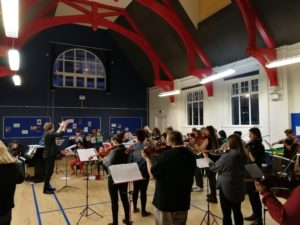
If you're in the UK, then come to our London School and join in with The Violin Orchestra!
The first rehearsal takes place this weekend (Saturday 15th June), and then we rehearse weekly on Saturday afternoons (Ensembles from 2pm, Orchestra from 3.30pm to 6pm) in Pimlico, SW1.
Orchestra repertoire will include The Devil's Trill by Tartini, and there will be Ensembles for every level, including chamber music by Bach and Handel, traditional Scottish and Irish folk music, and much more!
The Violin Orchestra is open to everyone - all ages and experience levels are welcome! - and music is arranged especially for the group, so there's a part for you whatever your technical level... whether you're an advanced player, or a beginner playing open strings!
Click here to find out more about the Violin Orchestra, and to register today!
Registration for our new Online Beginner Violin Course is now open! We've recorded a video to tell you all about it - check it out here!
We have 30 places available for the first online edition of the course (or you can sign up for ViolinSchool Membership for digital-only access).
p.s. this is the online version of the same Beginner Violin Course we run at our London school! The offline course runs again in September 2019 at our London school, and you can find details here.
Here's the next in our series of Intonation Exercises from the ViolinSchool Library - one per week, for you to improve the accuracy of your left hand placement!
Leap of Faith: Shifting big distances like these on a single string really does require a leap of faith!
But that faith will come from repeating the movement slowly lots of times, and being aware of your arm movement (especially the elbow movement) during the shift.
The smoother and more secure the arm and hand, the easier it is to drop your finger into exactly the right place.
Keep the frame of your hand secure but relaxed as you move!
Leap of Faith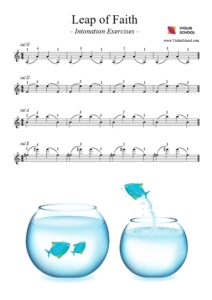 Click here to download it from the ViolinSchool Library!
Click here to download it from the ViolinSchool Library!
(login required)
We've just added a new piece of music to Course A and to the ViolinSchool Library... The Can-Can by Jacques Offenbach! Offenbach's famous 'Can-Can' is a classic of the genre... a high-octane dance that's full of energy, and sure to get your feet tapping! Here's an easy version in G major for Beginner violinists to try!
These new Scale Acceleration Exercises from Online Beginner Course A will help you to drill in your scale patterns in G, D and A major.
Once you've mastered the basic pattern, play through each scale using a long rhythm value (the exercise starts with a 4-beat semiquaver/whole note).
Then, play it again, but halve the note value to a 2-beat minim/half note. It'll feel like you're playing the scale much faster! And you'll be having to place the fingers in just half the time.
(Intermediate and Advanced players can do exactly the same thing with bigger scales that go into different octaves!).
We recommend using a metronome to help you maintain a secure pulse. Only change note on a metronome beat, to be sure that you are playing in time.
Before long, you'll find that you reach the limit of what you can currently do, and you'll find it hard to keep up with the metronome. When this happens, just go back a step, and practise the previous exercise (longer note values) a bit more.
At this point, you can also slow down your metronome beat and repeat the exercise at a slower speed. This will give you more time to clearly visualise your finger placement action.
Do this a few extra times to drill the pattern deeper into your muscle memory, and then try it again at a higher speed!
Having a good structure to your violin practice, as described in the Practice Menu, is important. But it isn't everything... you also need to be able to use time efficiently within your practice time.
That means knowing what to do... which types of exercises will be helpful, and which kinds of activities will guarantee you results?
It's a big topic, but a great place to start is with some of the most useful and effective practice techniques that have been proven time and again by violinists over many years.
Here's a useful checklist of some of the most popular techniques...
Download it from the ViolinSchool Library
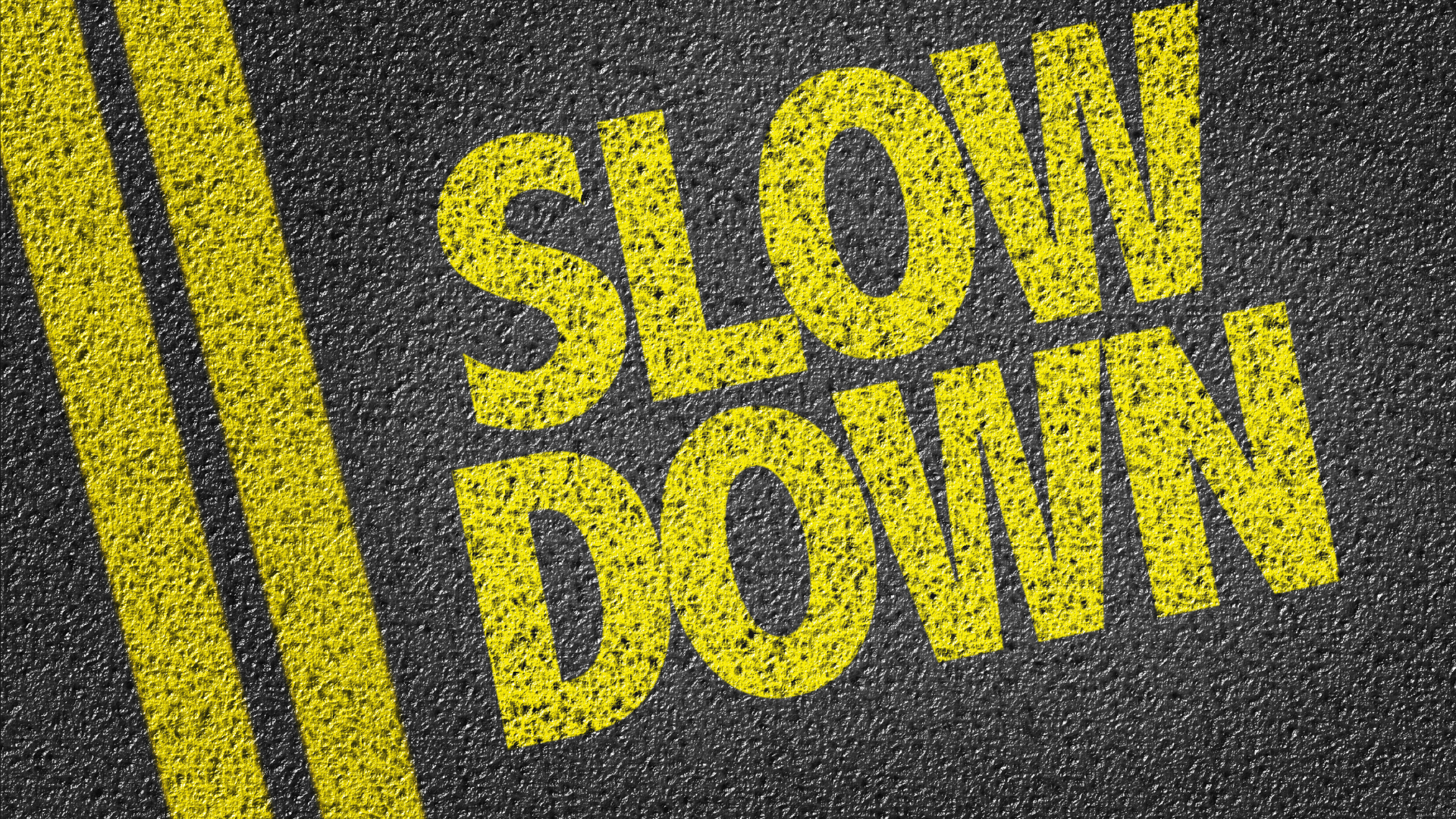
It seems obvious, doesn't it? If you play something underspeed, you have more time to think ahead and get it right. But slow practice gives you sooo much more than just more time. You'll also benefit from...
Accurate Repetition - The more you repeat something, the more it 'grooves' itself into your muscle memory. So obviously, it's better to groove those memories in accurately! And you're most likely to achieve a high level of accuracy when practising new motions, if you're playing them slowly!
Speed of Acquisition - When you're playing slowly, you've got more time to think about the detail of what you're doing. You can use this time to create a comprehensive visual image of how you are playing, in your imagination. This helps you to get the action more quickly into your subconscious memory than if you were playing it fast. So weirdly, slow practice = fast learning!
Proportion - Try approaching slow practice as if you are playing in 'slow motion'. What you're doing is just a slowed-down version of what you'd be doing at full speed. This is actually quite challenging to do, because you become aware of the subtlety of each element of your movements. But it really makes you think about how to improve your playing. Does your body balance? Are all your movements in good proportion to one another? Is each motion as efficient and smooth as it could be?
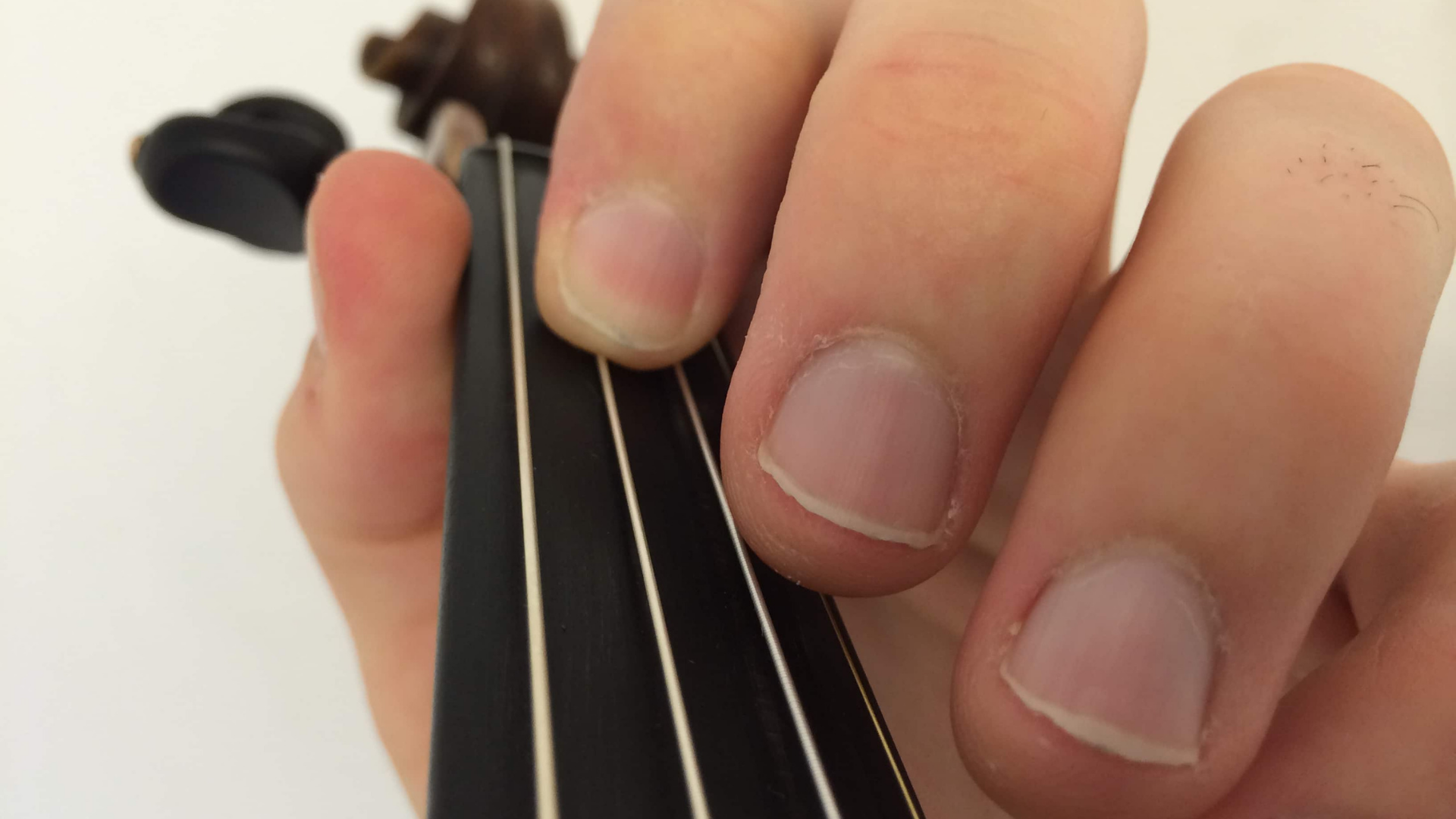
When we perform music on the violin, or play through pieces at speed, we have to rely a lot on the 'automatic' skills that we've built up during training. That's fine if you already know a piece of music well.
But if you're learning something for the first time, then it simply doesn't work to jump straight into playing things through. The detail of your muscle memory just isn't strong enough, and you'll become overwhelmed.
That's why it's important to break things down and isolate them... it allows us to focus on solving one issue at a time. Once that's done, we can carefully and slowly take the time to internalise each movement, until it's well 'grooved' into our muscle memory.
The same thing works for fixing problems in your violin practice. You need time and energy to focus on solving individual issues, one at a time, without distractions. Once you've fixed a passage of music at a slow speed, then you can test it at a higher speed!
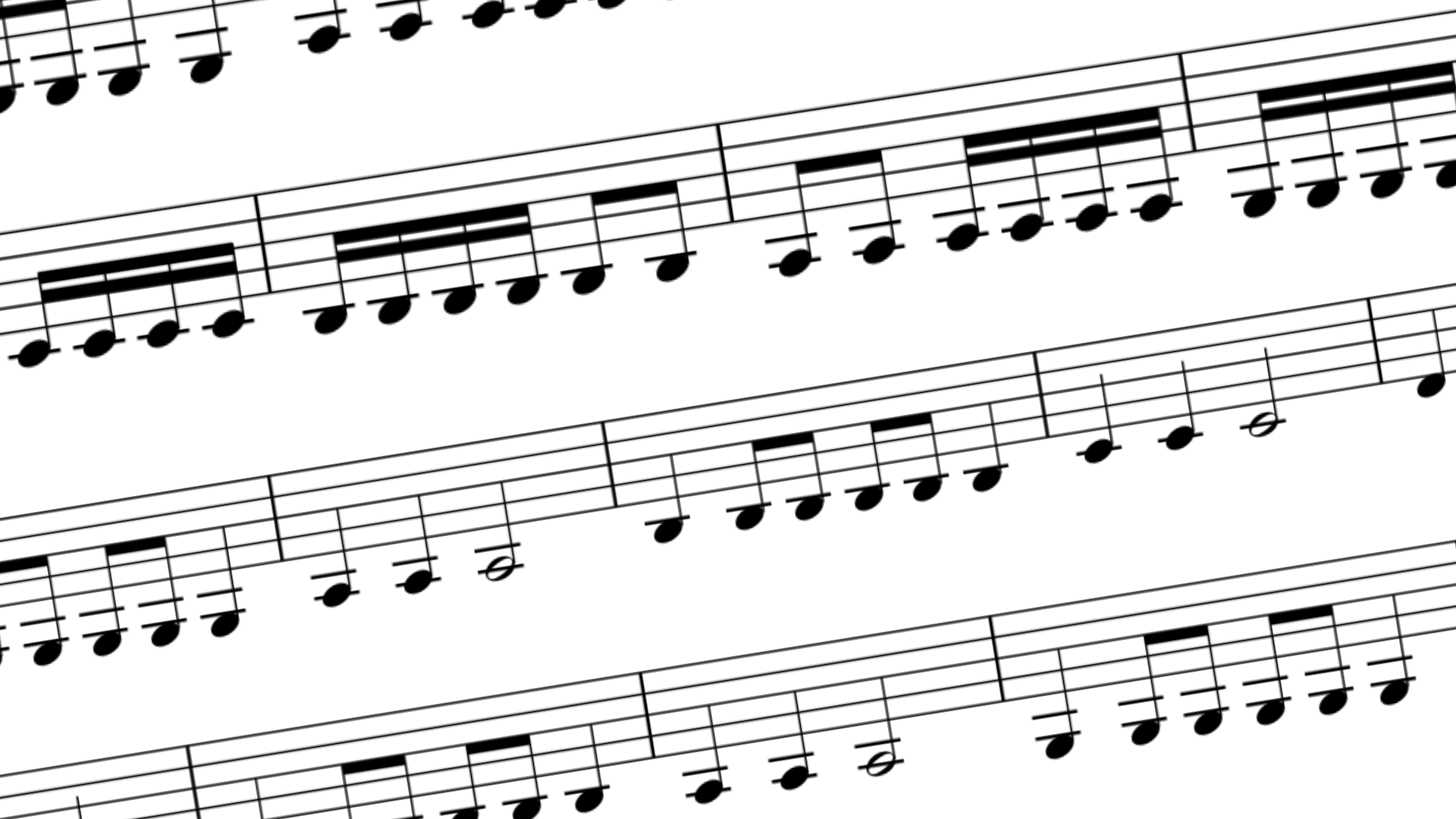
Once we have a solution to a problem, or we've learnt how a complex techinque works, we need to make our physical memory as strong as possible. Then we can recall each set of movements effectively and efficiently in performance - without needing to consciously think about it!
To do this, a different kind of 'breaking down' becomes useful... instead of simplifying a task by reducing complexity, we need to increase the complexity of the movements, in order to test and expand the limits of what we can do.
Adding complexity to a task places stronger and stronger demands on our technical capability and mental capacity. This forces us to depend more and more on our subconscious memory (i.e. our training). If we can monitor this effectively, then it's possible to predict accurately the level to which we can perform under pressure - which is a great way of reducing stress and performance anxiety!
Two of the most important ways of building up these skills are by varying the rhythm and bowing patterns that you use during practice. For example, you might be able to play a simple 2 or 3 octave scale using, for example, quarter notes on separate bows.
But try the same scale with dotted rhythms, changing the bow every three notes, and you'll have a MUCH harder challenge to complete!
Of course, it's sensible not to jump too far ahead of your current capability. So try to introduce rhythm and bowing variations that are only just outside of your comfort zone... challenging, but still doable!
As you introduce more rhythm and bowing changes, you'll find that you can cope with increasing amounts of complexity whilst playing, and the underlying tasks will become easier (such as, in this example, the original 2 or 3 octave scale).
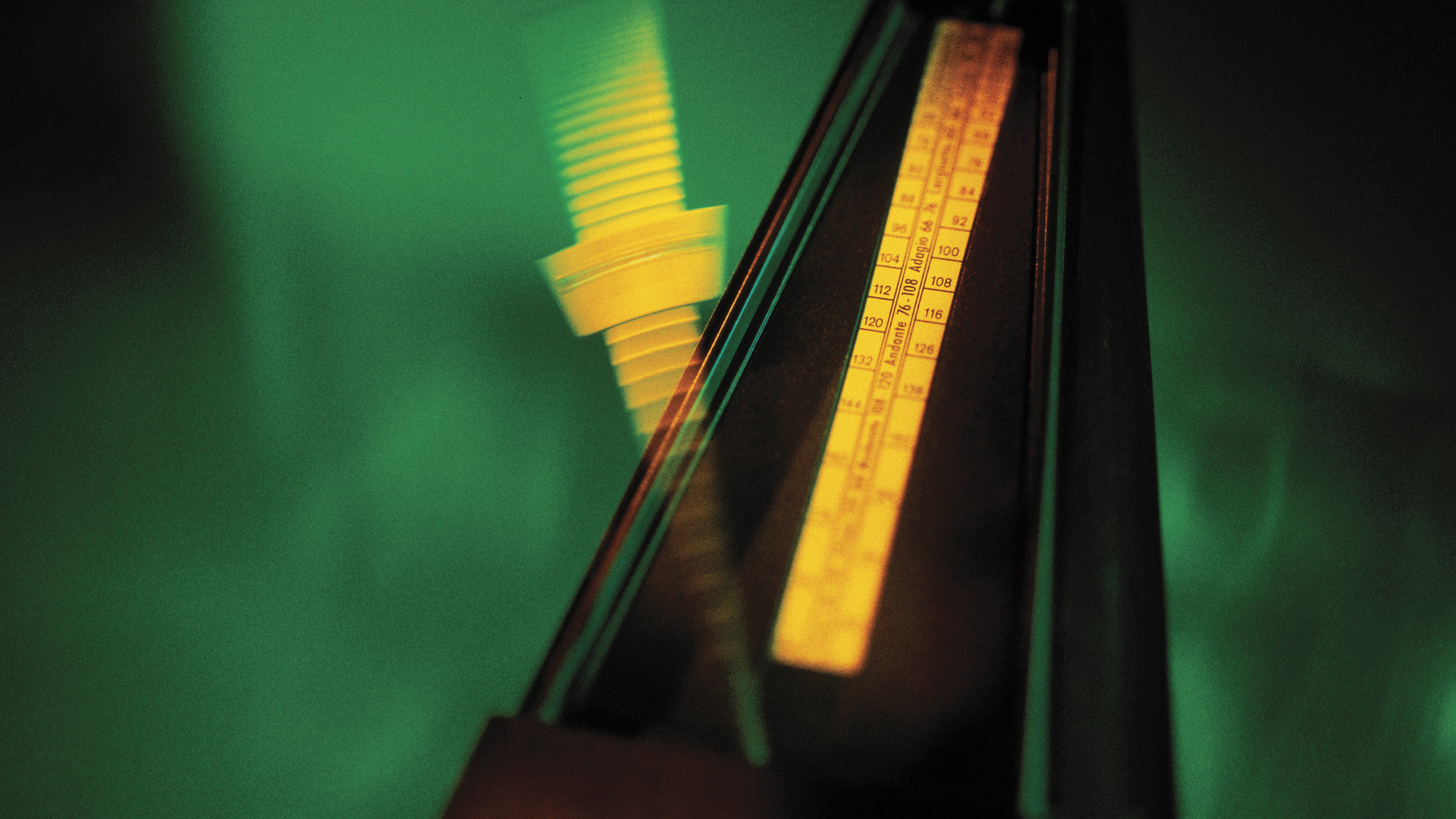
Timing is one of the most important aspects of music. And for music to make sense, the pitches we play have to be proportionate to each other!
Yes, that means you have to play the right rhythms. But those rhythms have to be right in proportion to the pulse of the music.
Our perception of time can become warped when we're concentrating on other things. So next time you face a challenging technical problem, try switching on a metronome. Keep listening to the metronome as you play, and you'll hear immediately if your timing becomes uneven.
Using a tool like a metronome means you have one thing to think about as you play. It frees up your brain to focus on whatever technical issue you're working on!
Better still, by premptively using the metronome to stop you from veering off-tempo, you avoid grooving in any timing errors whilst you're practising!
But, a warning... don't become addicted to the metronome! (Or to the tuner or mirror - see below). If you depend too much on the visual memory, it can cause other problems. But it's easily avoided... read Are You A Metronome Addict? to find out how!
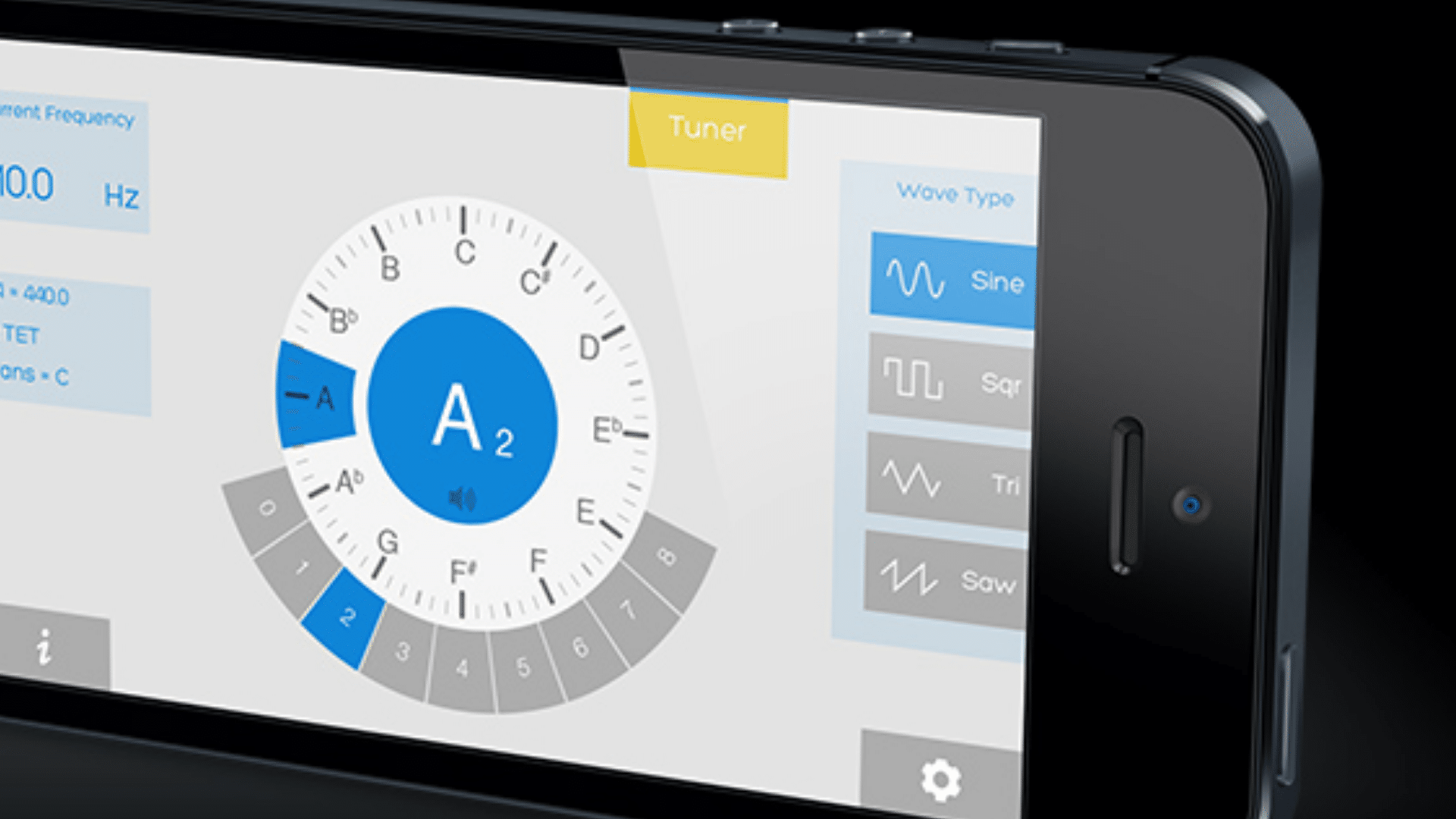
As with timing, it can be really helpful to have independent, objective feedback on your pitch as you practise. A tuning app will give you a visual read-out, which will show whether you are playing in tune or not.
It's best to use a tuner for testing, checking and correcting your playing... rather than just following along with the the visual cues!
Most 'intonation practice' (i.e. practising your finger placement, and tuning the notes correctly) benefits from slow practice, because when you are bowing with clear, full, slow bow strokes, then it is much easier to create a big, beautiful and resonant sound.
And that's the kind of sound you need to hear, in order to make good solid decisions about your intonation!
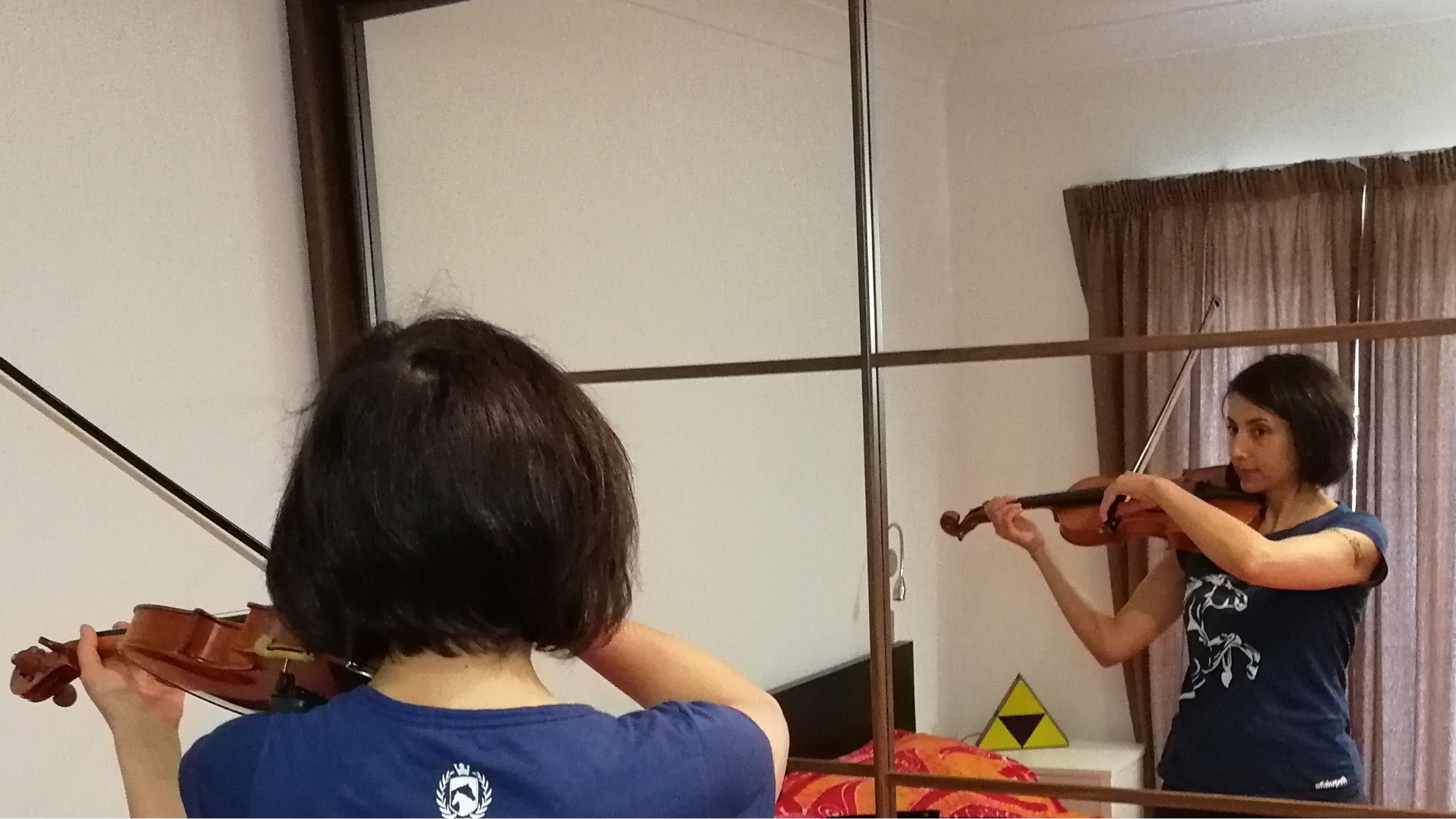
Mirrors are great for giving visual feedback on your technique. As your experience grows, you'll develop a second sense for what 'looks right' when playing the violin, and a quick glance in a mirror can give you instant feedback on whether what you're doing is effective or not.
As with the metronome and the tuner, don't become reliant on the mirror... instead, position yourself so that you can look into it easily, without turning your head.
If you're monitoring your bowing, then you'll need to rotate your body slightly to the left (as you're looking at the mirror, so that your feet are pointing at approximately a 45 degree angle to the left of the mirror.
Then you'll be able to see clearly whether or not your bow angles are correct, and whether the bow is approximately parallel to the bridge or not.
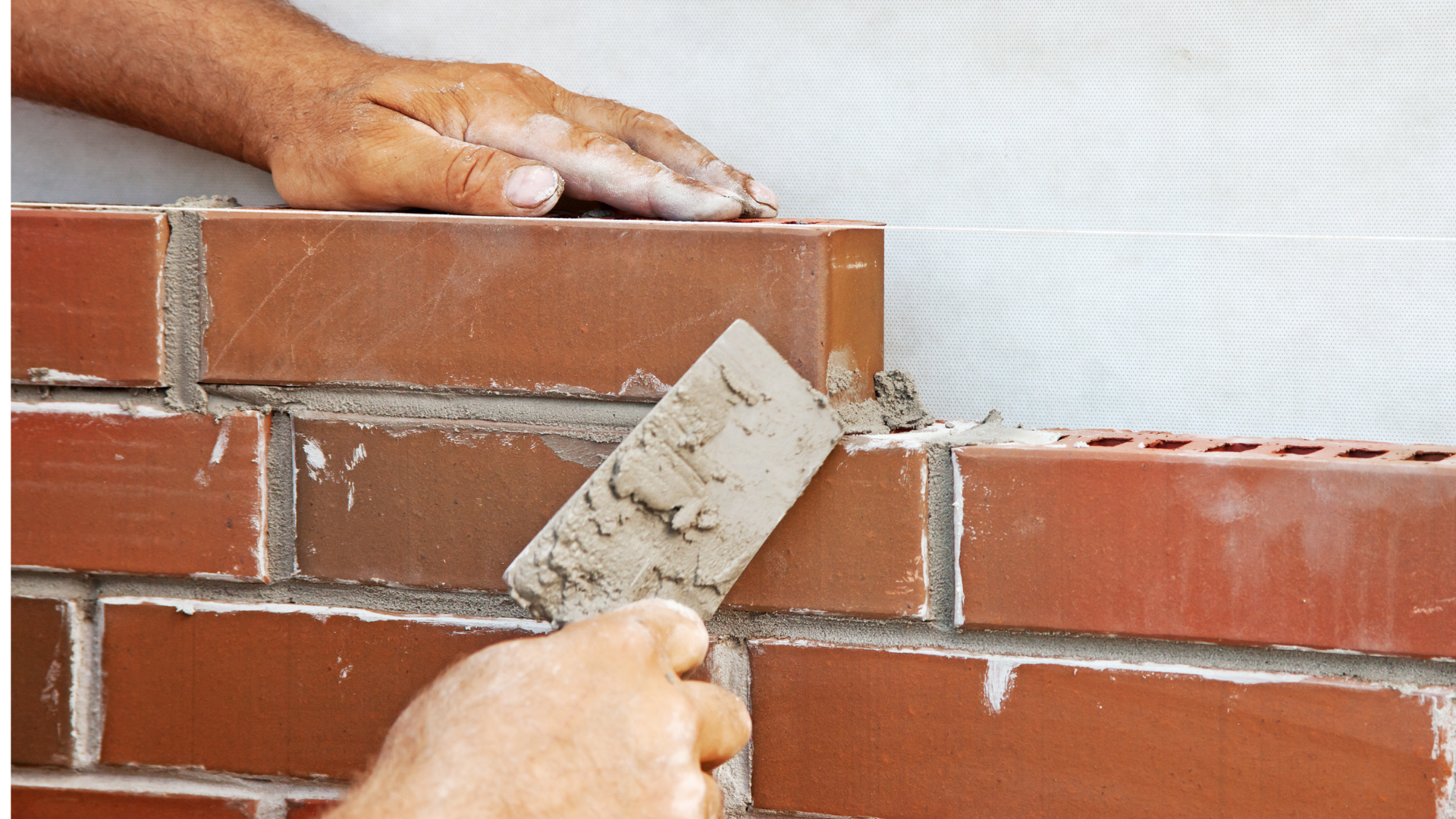
Learning a piece of music conscientiously is a bit like building a brick wall! Each brick needs to be carefully connected to the bricks next to it, so that you end up with a smoooothly constructed, neatly finished end product.
A great way of doing this is by breaking down the music that you're learning into 'blocks'. How big the blocks are is up to you - 1 block could equal 1 bar, or 1 phrase, or any other quantity that you think is appropriate!
Once you've practised each block, you then practise together with the next one.
Practise Block A, then Block B, then Blocks A + B together.
Then practise Block C, then Blocks B + C together.
Then practise Blocks A, B + C together.
Extend and repeat this for as long as you feel necessary!
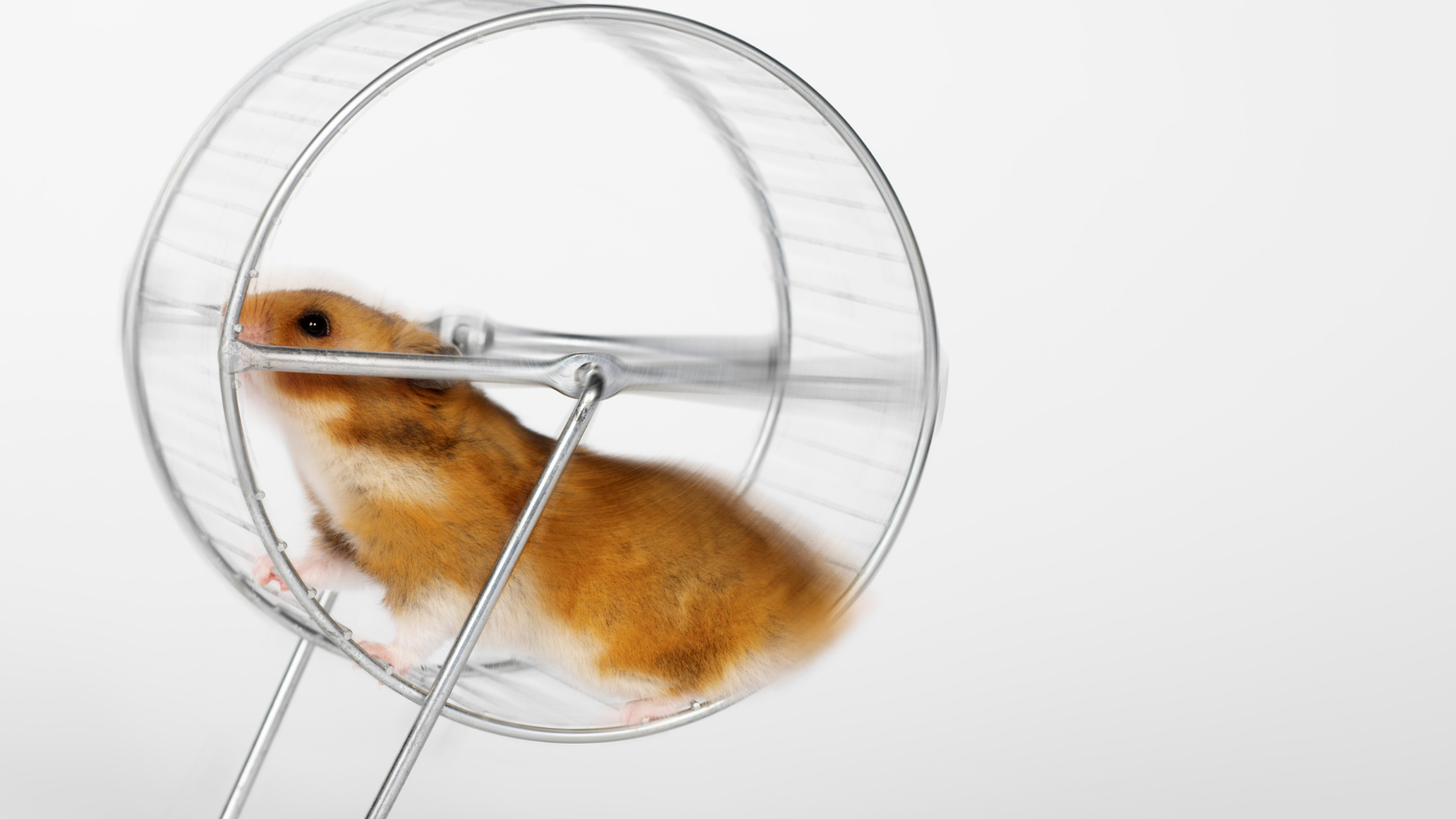
This one's simple. Solved a problem? Fixed a technical issue? Then 'loop' it - repeat it over and over again - until you've drilled the memory super-deep into your muscles!
Repetition is really powerful though, so be really careful that you're grooving in the right motions before you start looping things!

Good Technique is really important, but ultimately, most people play music on the violin in order to communicate emotion, and technique is only the means to that end.
Try exploring different ways of playing all the music that you practise... experiment with styles and characters that go beyond what you think you might eventually use. This way you'll discover interesting insights and perspectives; you'll think about the music you're playing in a new way.
Also, don't leave the 'musical' or 'expressive' side of things until too late in your practice... your technique needs to adapt to support your musical decisions, so begin experimenting with different musical ideas well before your technical motions are finalised.
We've just updated our edition of the much-loved folk song, Long, Long Ago and it's now available to download (free login required!) from the ViolinSchool library... just click here:
The song dates back to the early 1830s, when it was written by the English writer and poet Thomas Haynes Bayly. It became famous after it was published in America in the mid-19th century, and has remained in wide circulation ever since.
The piece has been a firm favourite amongst violinists for many years, not least because of its prominent positioning in Suzuki Violin Book 1 - one of the best-selling violin books of the last hundred years!
Here's the next in our series of Intonation Exercises from the ViolinSchool Library - one per week, for you to improve the accuracy of your left hand placement!
Copycat: Play an interval on one string, and then play the same notes in a different place on the violin, by moving to a different string and a different position...
But be careful, Copycat... you need to aim for exactly the same pitch, wherever you climb!
Copycat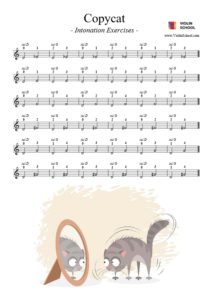 Click here to download it from the ViolinSchool Library!
Click here to download it from the ViolinSchool Library!
(login required)
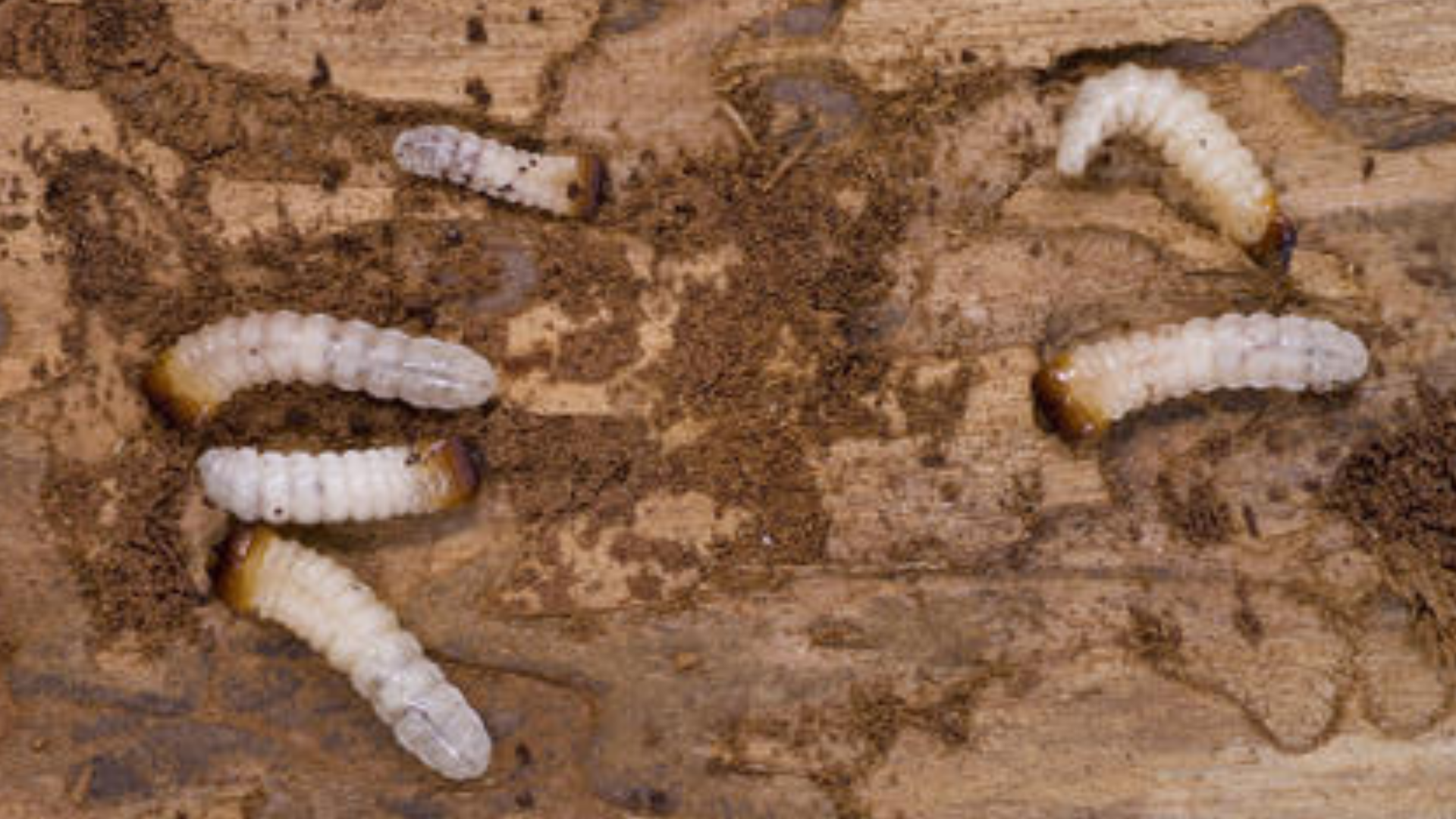
To a violinist, a violin is a beautiful work of art, whose sound can generate the deepest and most profound emotions known to humankind.
But to woodworm, a violin is a very tasty lunch!
Let's explore how woodworm can damage violins, and what you can do to avoid woodworm problems in your violin!
What are Woodworm, anyway?
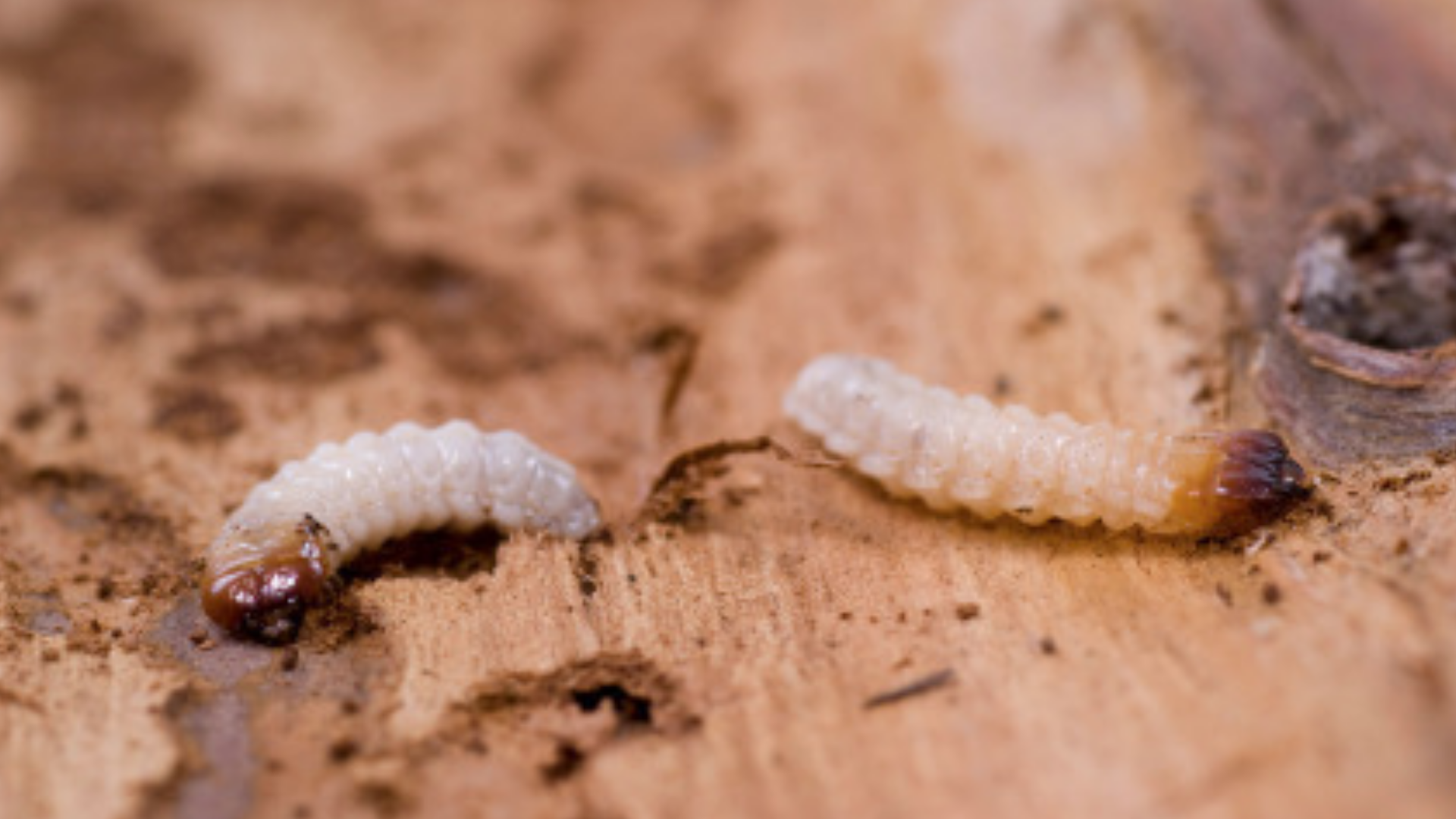
Well, they're not worms. Woodworm are actually the larvae of wood boring beetles - and a violin is a nice place for that larvae to live, before it becomes a beetle!
The wood boring beetles usually emerge from wood during the summer months - so generally between May and October in the northern hemisphere.

If you're aware of what a woodworm infestation looks like, then you have a chance of spotting it early... before it's too late to be treated!
The Best Conditions for Eating a Violin (if you're a woodworm!)
Obviously Woodworm love wood... but they're also attracted by humidity. So a humid violin makes for a great hot meal!
It all starts after mating, when a female beetle will look for small cracks in wood, where it can safely lay its eggs.
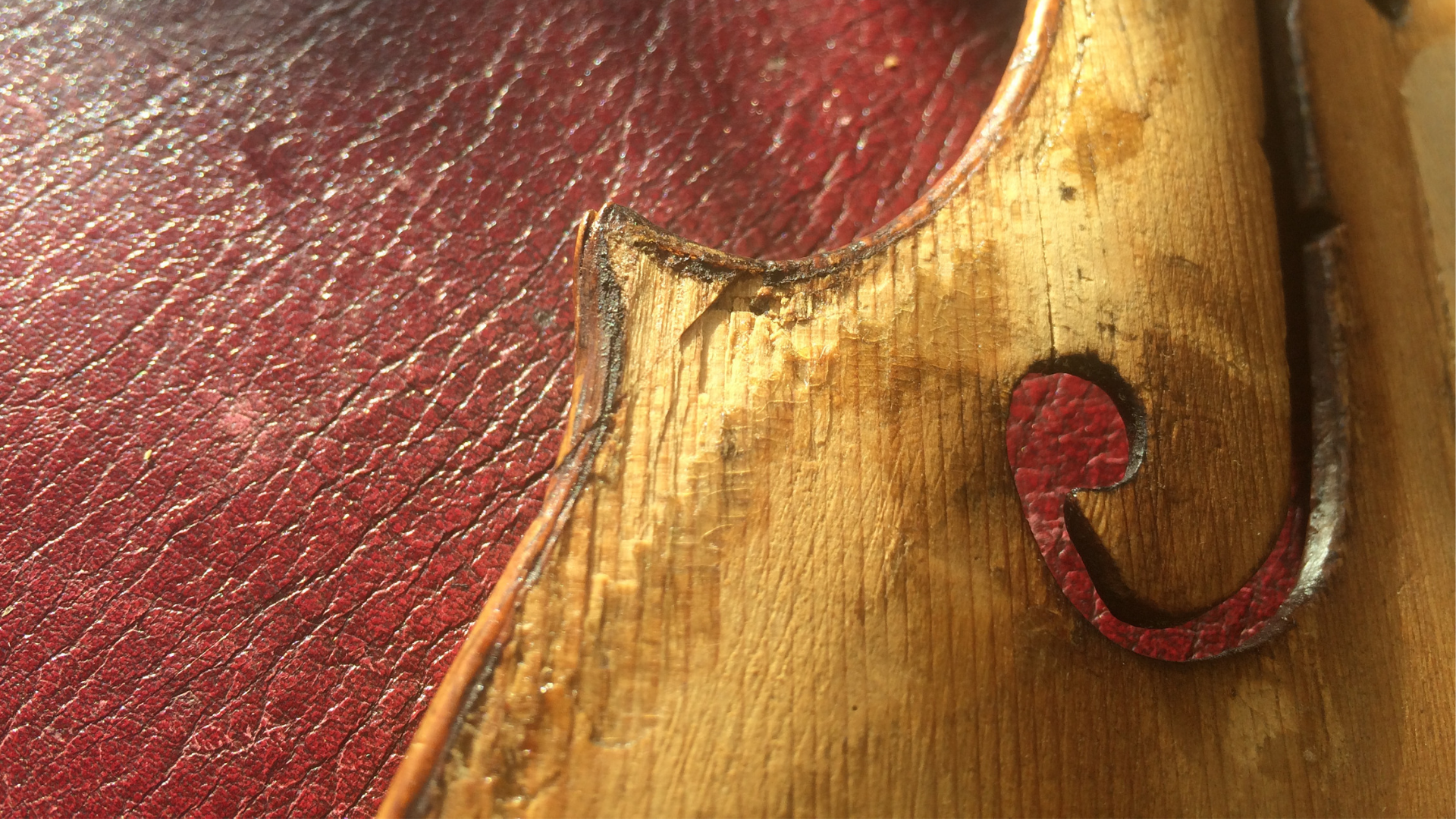
For this reason, you're unlikely to have a woodworm problem in a new or new-ish beginner instrument that's recently rolled out of a mass production workshop.
But if you have an antique violin, particularly one that's had repair work done to it in the past, this is definitely something to be aware of - particularly if you're in a humid part of the world.
Ready to Hatch... and Munch!
Once the eggs hatch, the larvae will burrow downwards into the wood of the violin, and eat their way up and down for anywhere up to five years! This can cause extensive structural damage.
The larvae form 'pupal chambers' - spaces where they enlarge the burrowing tunnels towards the surface of the wood, so that they have space to pupate into fully grown adult beetles.

Each beetle then eats its way out of the wood, in order to search for a mate. Once they're successful, the process begins all over again.
Woodworm can cause significant damage to violins by eating their way through the wood whilst they're still in their larval stage.
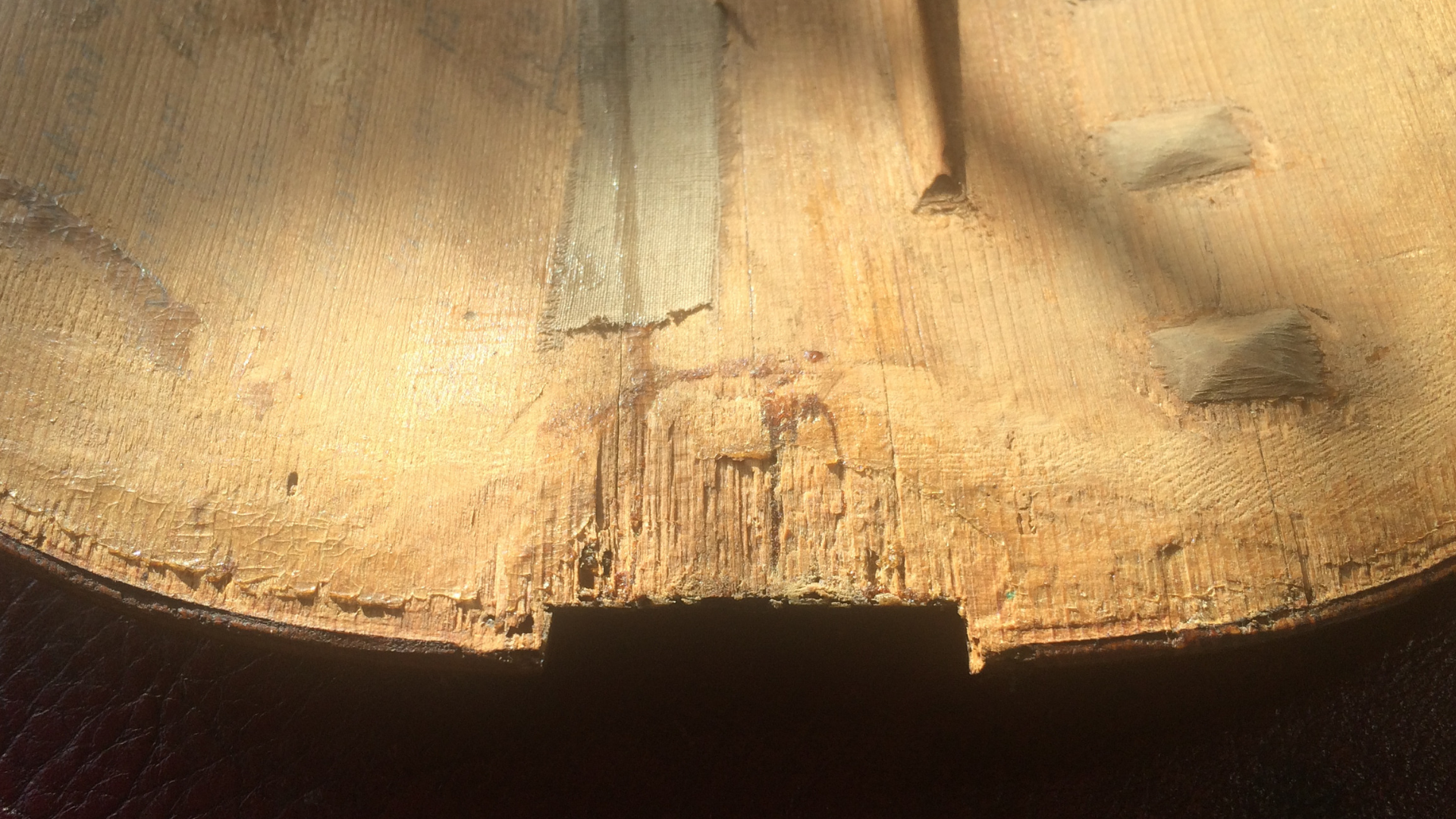
The Early Bird Catches The Woodworm
It's essential for violinists to identify the signs of a woodworm infestation before it becomes too severe, and the instrument becomes damaged beyond repair.
It's not clear whether larvae are affected by a musical instrument being played... but as far as we're aware, they don't have particularly strong musical opinions!
On a practical level, it's easier to spot woodworm deterioration if you're handling an instrument regularly, than if it's locked up in a storage unit!
That's why woodworm is a greater worry for collectors or people buying second hand instruments, than for violinists who are playing their instruments regularly.
HOW TO IDENTIFY WOODWORM
Finding Burrow Holes and Tunnels in a Violin
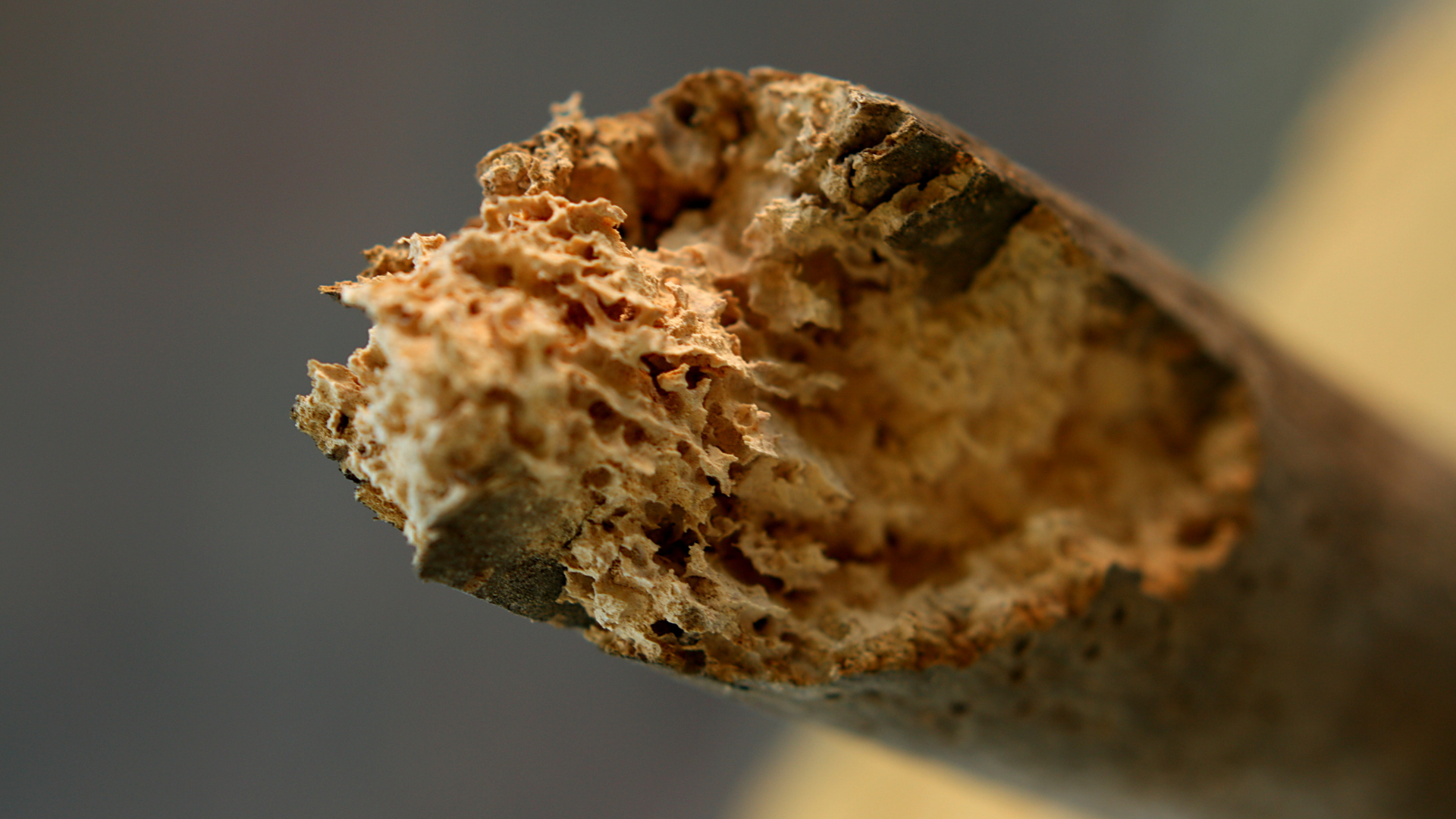
When the beetle is looking for a mate, it eats its way through the wood. On the way out, it creates a small exit hole ('burrow hole') in the violin.
These holes look similar to the holes that darts make when thrown into a dartboard!
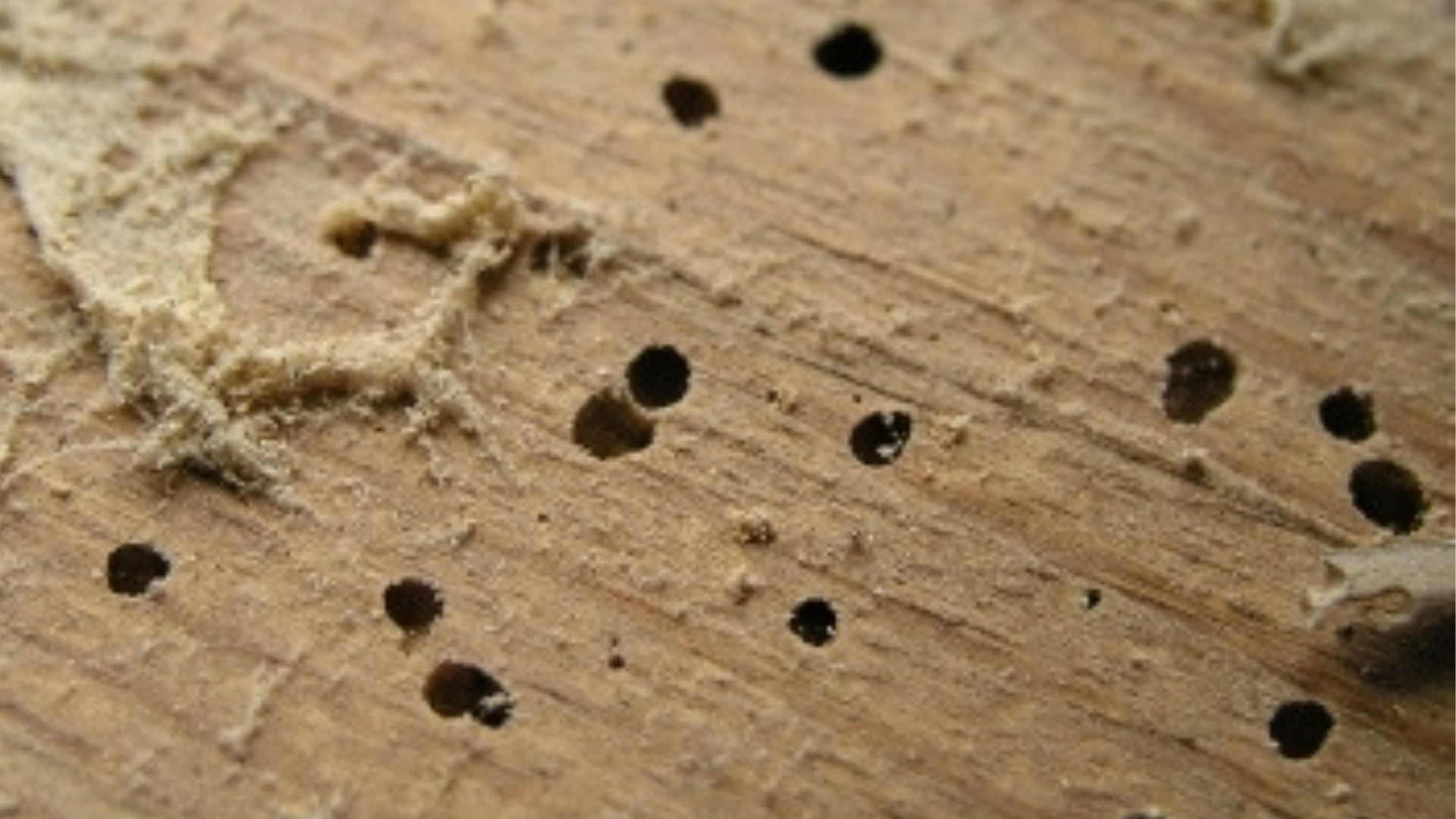
If you notice burrow holes in a violin, then you should first establish whether or not the infestation is still active.
You need to know this in order to assess the level of damage that has been caused to the violin.
Its possible that there may still be wood boring beetles inside the instrument - but this can't be determined by the burrow holes alone.
Instead, look for raised “tunnels” within the wood. These tunnels indicate the route taken by the larvae as it eats through the violin.
Frass
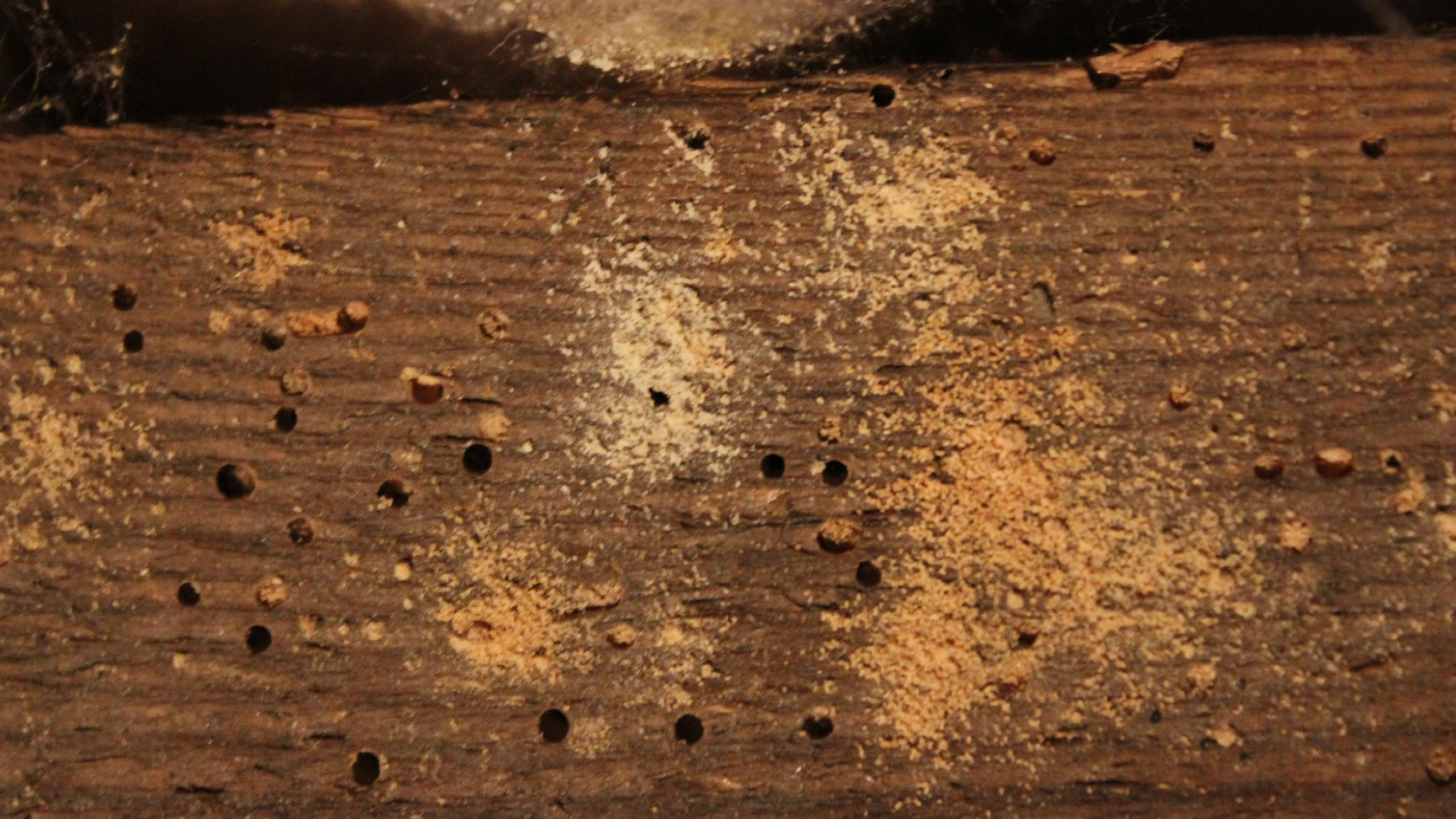
A key sign of an active infestation in a violin is 'frass', a fine powdery dust which looks like moist sawdust, and is found near the burrow holes.
This powdery dust is essentially woodworm poo! It's the faeces that the beetle larvae leave behind after they've eaten. Mmmm, delicious!
Frass is generally a sign of a woodworm infestation at the larval stage (not the result of new beetles emerging).
Crumbly Edges
Over time, the number of woodworm will multiply if the infestation isn’t treated.
This will result in an increase in the amount of exit holes in the violin, making the edges of the wood appear crumbly.
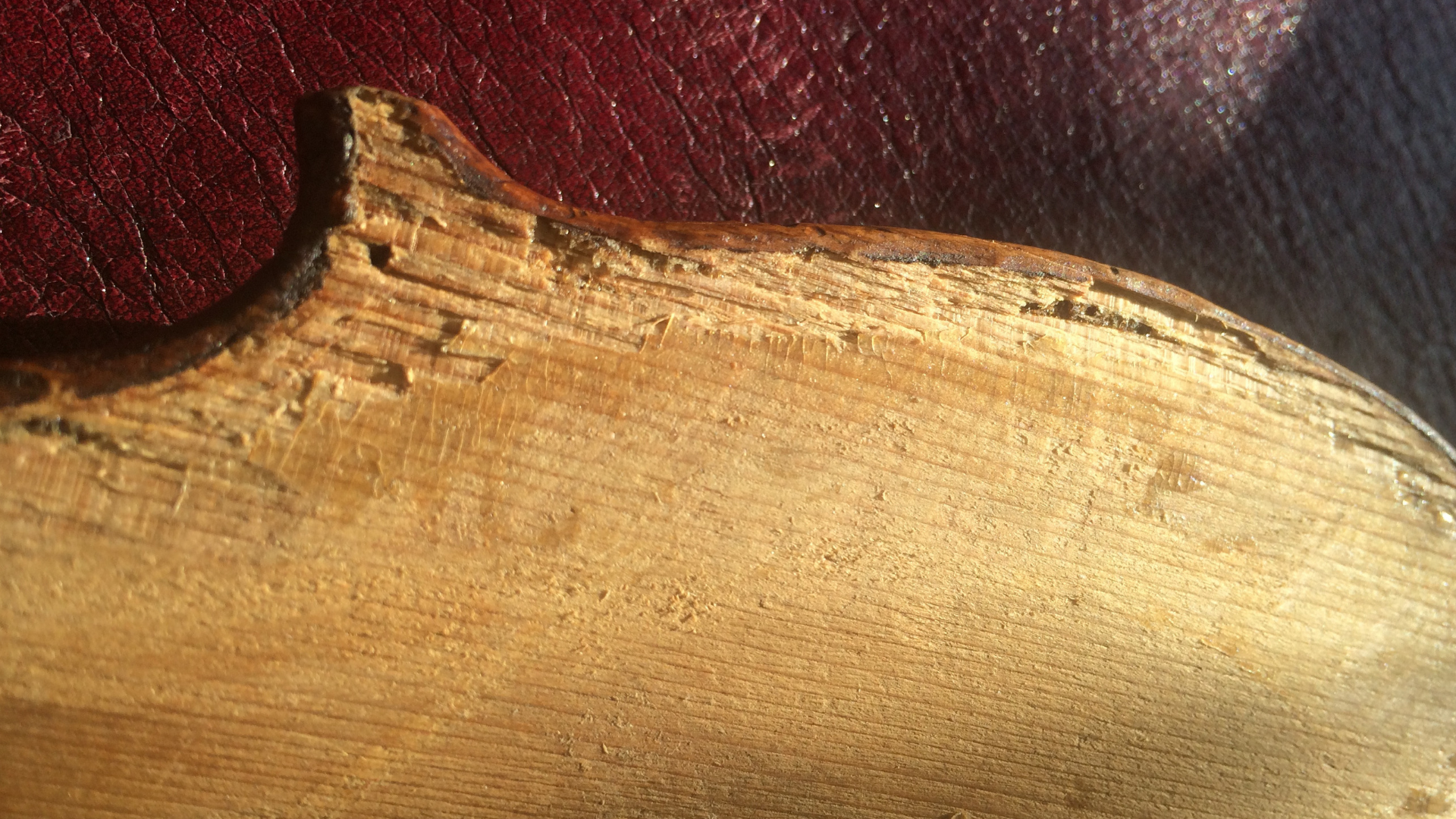
Crumbly edges indicate that the woodworm infestation has been active for a long time. In this instance, immediate treatment is necessary to prevent further damage to the violin.
Beetles Found... Dead or Alive!
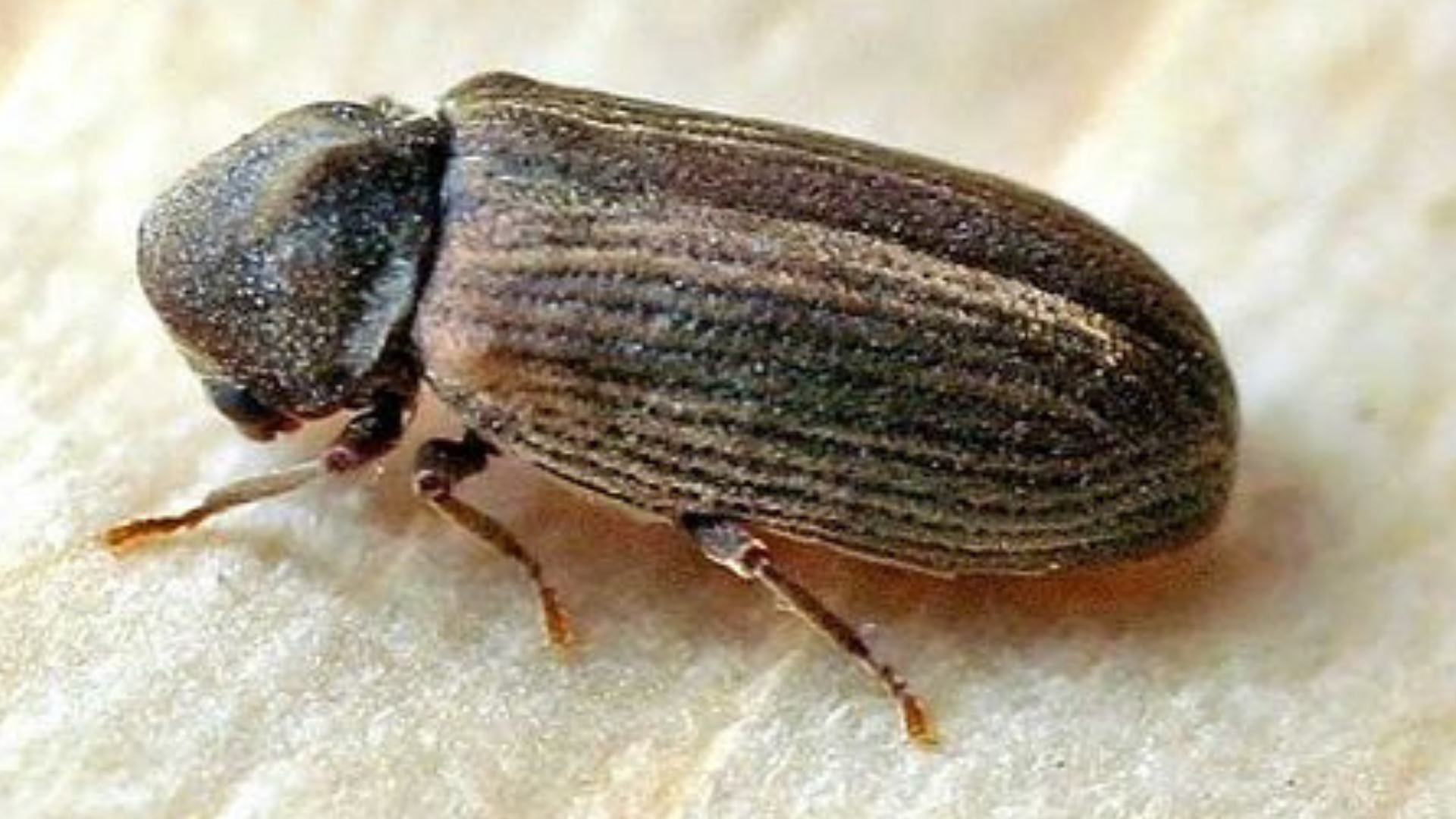
The strongest indication that your violin has suffered a woodworm infestation is if you find beetles - dead or alive! - in close proximity to the instrument.
If you actually see beetles emerging from the exit holes in the violin, then you're almost certainly dealing with an active woodworm infestation.
Beetles generally emerge from the burrow holes in summer, after having caused damage during the larval stage.
In the United Kingdom, the 'Common Furniture Beetle' (a small, brown beetle) is extremely common. These beetles are prone to dying just a few days after mating, so they can often be found lying dead near the infested wood.
WHAT DO I DO IF I SUSPECT WOODWORM IN MY VIOLIN?
The adult beetle itself causes very little damage to wood. But after mating, the female beetles will fly around in search of nearby wood to lay their eggs.
Therefore, if you notice signs of woodworm in your violin, there's a risk that if the infestation remains untreated, that it could spread to other instruments and furniture.
For this reason, it's strongly recommended to get advice immediately from an experienced luthier, as soon as you suspect woodworm in your violin!
Additional research by Jake Ryan of Wise Property Care
Additional violin images courtesy of Bridgewood & Neitzert, London
